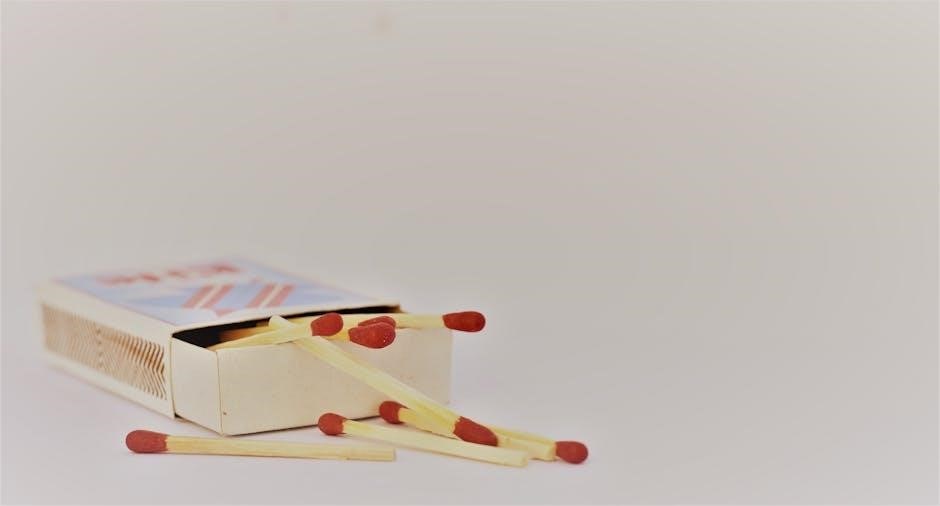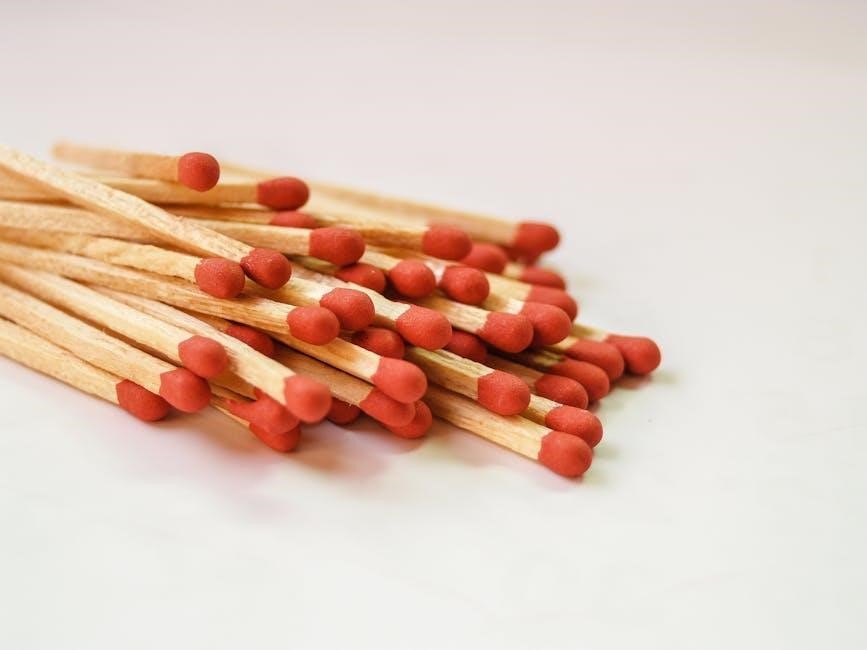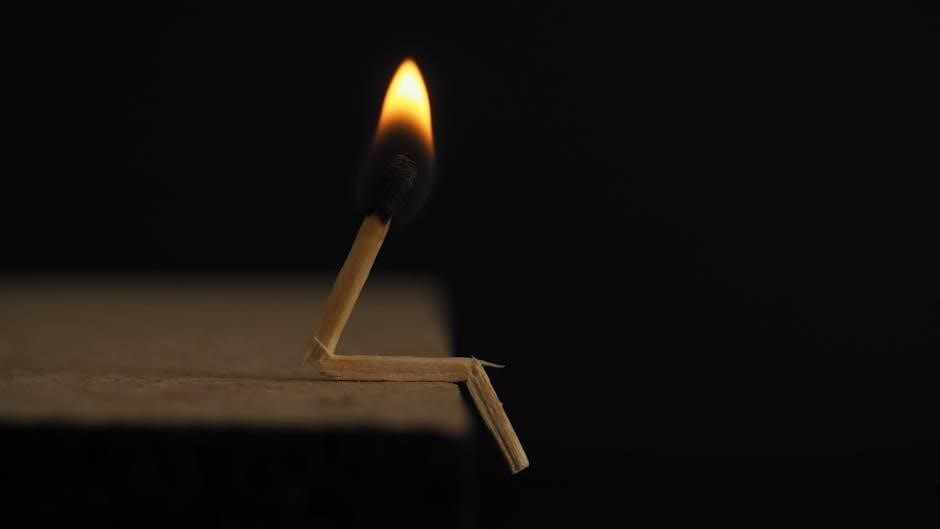
Fire sprinkler heads are a critical component of fire suppression systems, activating when heat reaches a preset temperature to release water and control fires effectively.
1.1 Overview of Fire Sprinkler Systems
Fire sprinkler systems are designed to detect and suppress fires automatically, ensuring safety and minimizing damage. These systems consist of a network of pipes, valves, and sprinkler heads, which activate when heat from a fire reaches a predetermined temperature. They are highly effective, with statistics showing they control or extinguish fires in over 90% of cases, making them a critical component of fire safety in buildings.
1.2 Importance of Fire Sprinkler Heads
Fire sprinkler heads are essential for effective fire suppression, activating automatically when exposed to heat, thus controlling or extinguishing fires early. Their reliability, with over 95% effectiveness, makes them crucial for protecting lives and property. Sprinkler heads are tailored to various environments, ensuring optimal performance in different fire scenarios, and their proper installation and maintenance are vital for ensuring safety and compliance with fire safety standards.

Types of Fire Sprinkler Heads
Fire sprinkler heads are categorized into types like pendent, upright, sidewall, and concealed, each designed for specific applications and environments to ensure effective fire suppression.
2.1 Pendent Sprinkler Heads
Pendent sprinkler heads are the most commonly used type, suspended from the ceiling, providing a wide coverage area with a domed water distribution pattern. Their visibility and reliability make them suitable for various applications, including commercial and residential spaces, effectively suppressing fires by targeting the source directly with their heat-activated mechanisms.
2.2 Upright Sprinkler Heads
Upright sprinkler heads are installed with the deflector facing upwards, ideal for areas with high ceilings or obstructions. They project water downward in a hemispherical pattern, effectively covering large spaces. Commonly used in industrial settings, they provide reliable fire suppression by targeting the fire source directly, ensuring optimal water distribution for controlling and extinguishing flames efficiently in open or high-ceiling environments.
2.3 Sidewall Sprinkler Heads
Sidewall sprinkler heads are mounted on walls, directing water in a wide, fan-shaped pattern for coverage. They are ideal for areas with sloped or uneven ceilings, providing effective fire suppression in corridors, stairwells, and small rooms. Their discreet installation maintains aesthetics while ensuring reliable protection, making them a popular choice for residential and light commercial spaces requiring unobtrusive fire safety solutions and efficient water distribution systems.
2.4 Concealed Sprinkler Heads
Concealed sprinkler heads blend seamlessly into ceilings, offering a visually appealing option for fire protection. These heads are recessed and covered with a decorative cap, making them nearly invisible until activation. They provide efficient fire suppression while preserving architectural aesthetics, ideal for high-end commercial spaces, luxury homes, and areas where design is a priority, ensuring both safety and style are maintained effectively and efficiently.

Specialized Fire Sprinkler Heads
Specialized fire sprinkler heads enhance modern fire suppression systems, offering tailored solutions for unique challenges. These heads feature advanced designs to optimize water distribution and heat sensitivity, ensuring enhanced fire safety and property protection efficiently.
3.1 Recessed Sprinkler Heads
Recessed sprinkler heads are installed into ceilings, blending seamlessly with the surrounding area. They feature a discreet design, making them ideal for aesthetic-conscious spaces. These heads are typically equipped with heat-sensitive elements, ensuring they activate only when necessary, providing reliable fire suppression while maintaining visual appeal. Their recessed nature allows for efficient water distribution without compromising interior design.
3.2 Mist Sprinkler Heads
Mist sprinkler heads discharge a fine water spray, ideal for light to ordinary fire hazards. Their compact design and precise water distribution make them effective in cooling and controlling fires. With temperature-sensitive elements, they activate when heat is detected, releasing a mist that reduces fire intensity and prevents spread. This type is particularly suited for applications requiring minimal water usage while maintaining robust fire suppression capabilities.
3.3 Extended Coverage Sprinkler Heads
Extended coverage sprinkler heads are designed to protect larger areas with a wider spray pattern. They are ideal for light to ordinary fire hazards in spaces like warehouses or large commercial buildings. These heads provide reliable fire suppression by distributing water over an extended area, ensuring comprehensive coverage and effective fire control. Their design maximizes efficiency in open spaces, making them a versatile choice for various applications.
Installation Considerations
Proper installation of fire sprinkler heads requires evaluating hazards, spacing, and compliance with standards like NFPA 13. Ensure correct placement and positioning for optimal fire suppression efficiency.
4.1 Choosing the Right Sprinkler Head Type
Selecting the appropriate fire sprinkler head type involves evaluating the building’s occupancy, hazards, and specific conditions. Factors such as ceiling height, water supply, and ambient temperature play a crucial role. Pendent, upright, and sidewall sprinklers are commonly chosen based on coverage needs and space requirements. Compliance with NFPA standards ensures optimal performance and safety. Proper selection enhances system effectiveness and reliability in fire suppression scenarios.
4.2 Placement and Spacing Requirements
Proper placement and spacing of fire sprinkler heads are essential for effective fire suppression. NFPA guidelines dictate specific distances and locations to ensure adequate coverage. Typically, sprinklers are spaced 10 to 15 feet apart, depending on the type and hazard level. They must be installed away from obstructions and aligned to provide unimpeded water distribution, ensuring maximum efficiency in controlling or extinguishing fires promptly.

Maintenance and Inspection

Regular maintenance and inspections are crucial for ensuring fire sprinkler systems function properly. This includes checking for corrosion, cleaning sprinkler heads, and testing valves to meet safety standards.
5.1 Regular Maintenance Practices
Regular maintenance practices for fire sprinkler heads involve inspecting for corrosion, cleaning debris, and ensuring proper water flow. Testing valves, draining systems, and replacing worn components are essential. Compliance with NFPA standards ensures system reliability and effectiveness in emergencies.
5.2 Inspection Frequency and Procedures
Inspect fire sprinkler heads weekly for damage or obstructions and monthly for valve operation and alarm functionality. Annual inspections by certified professionals are required to test water flow and drainage. NFPA guidelines recommend detailed checks of sprinkler heads, pipes, and control valves to ensure system reliability and compliance with safety standards.

Design and Functionality Differences
Fire sprinkler heads vary in design, with differences in heat activation, water distribution patterns, and coverage areas, ensuring tailored fire suppression for specific applications and environments.
6.1 Heat-Activated Mechanisms
Fire sprinkler heads are equipped with heat-activated mechanisms, such as glass bulbs or fusible links, designed to rupture or melt at specific temperatures. These mechanisms trigger water release when heat reaches a preset threshold, ensuring timely fire suppression. Advanced models feature quick-response bulbs for faster activation, enhancing fire control effectiveness in critical situations.
6.2 Water Distribution Patterns
Fire sprinkler heads deliver water in various patterns, including circular, hemispherical, or targeted streams; Pendent and upright heads provide broad coverage, while sidewall models focus on specific areas. The design of the deflector determines the spray pattern, ensuring effective fire suppression based on the type of hazard and building layout, optimizing water distribution for maximum fire control efficiency.
Applications in Different Building Types
Fire sprinkler systems are essential in residential, commercial, and industrial buildings to protect against fires. They are tailored to specific hazards and building layouts, ensuring optimal fire suppression in diverse settings.
7.1 Residential Fire Sprinkler Systems
Residential fire sprinkler systems are designed to provide early fire detection and suppression, enhancing home safety. They often use concealed or sidewall sprinkler heads for aesthetic appeal, distributing water effectively to control fires. These systems are tailored to protect living areas, ensuring quick activation and minimal damage. Their installation is increasingly mandated in new constructions to reduce fire risks and save lives.
7.2 Commercial and Industrial Fire Sprinkler Systems
Commercial and industrial fire sprinkler systems are tailored for large-scale protection, often using pendent, upright, or extended coverage sprinkler heads. These systems are designed to handle high-hazard environments, ensuring robust fire control and minimizing damage. They prioritize reliability and durability, with regular maintenance and inspections being critical to their effectiveness in safeguarding people, equipment, and facilities.
Standards and Regulations
Fire sprinkler systems must comply with NFPA 13 and 13R guidelines, ensuring safety and reliability. UL listings verify sprinkler heads meet rigorous testing standards for performance and durability.
8.1 NFPA 13 and 13R Guidelines
NFPA 13 and 13R provide detailed standards for fire sprinkler systems, ensuring proper design, installation, and maintenance. NFPA 13 applies to commercial systems, while NFPA 13R focuses on residential applications. These guidelines specify requirements for sprinkler head types, placement, and water supply, ensuring systems are effective in controlling fires and protecting lives and property.
8.2 UL Listings and Certifications
UL listings and certifications ensure fire sprinkler heads meet rigorous safety and performance standards. These listings verify that sprinklers function reliably under various fire conditions, covering aspects like water distribution, thermal sensitivity, and durability. UL certification applies to different sprinkler types, ensuring compliance with local fire codes and building regulations, while maintaining public safety and insurance requirements. Manufacturers must meet UL’s testing criteria to achieve and maintain certification.

Comparison of Sprinkler Head Types
Fire sprinkler heads vary in design, coverage, and activation mechanisms, offering tailored solutions for different fire hazards and architectural needs, ensuring optimal fire suppression efficiency.
9.1 Advantages and Disadvantages
Fire sprinkler heads offer significant advantages, including rapid fire control, minimizing damage, and high reliability. However, they may require regular maintenance, risk accidental activation, and pose aesthetic or space challenges in certain settings, impacting their overall suitability for specific applications.
9.2 Cost and Aesthetic Considerations
Fire sprinkler heads vary in cost, with pendent and upright types being more affordable and widely used in commercial settings. Concealed heads, while aesthetically pleasing, are pricier due to their hidden design. The choice often depends on balancing fire safety needs with budget and visual preferences, especially in residential or design-focused spaces where appearances matter.
Fire sprinkler heads are essential for modern fire safety, offering reliability and effectiveness in controlling fires. With various types available, proper selection and installation ensure optimal protection and compliance with safety standards.
10.1 Summary of Key Points
Fire sprinkler heads are categorized into types like pendent, upright, sidewall, and concealed, each designed for specific applications. Proper selection ensures effective fire suppression, while regular maintenance and adherence to standards like NFPA 13 are crucial for reliability. With a 95% effectiveness rate, sprinklers remain a vital component in safeguarding lives and property, offering tailored solutions for diverse building requirements and hazards.
10.2 Final Thoughts on Selection and Installation
Selecting the right fire sprinkler head type and ensuring proper installation are critical for effective fire suppression. Consider building occupancy, hazards, and ceiling types when choosing between pendent, upright, sidewall, or concealed heads. Licensed professionals should design and install systems to meet NFPA standards, ensuring reliability and compliance. A well-designed system enhances safety, property protection, and peace of mind, proving its value in emergencies.